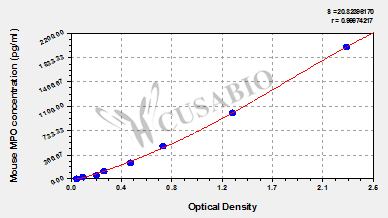The mouse MPO ELISA Kit is engineered for accurate measurement of mouse MPO levels from samples including serum, plasma, cell culture supernates, or tissue homogenates. It uses the Sandwich-ELISA mechanism in combination with the enzyme-substrate chromogenic reaction to measure the MPO content in the sample. The color intensity is positively correlated with MPO content in the sample. This kit has been validated against standards of sensitivity, specificity, precision, linearity, recovery, and lot-to-lot consistency.
MPO is a key component of the innate immune system and is mainly released by neutrophils to defend against invading pathogens. MPO catalyzes the reaction of H2O2 with chloride ions (Cl−) to form hypochlorous acid (HOCl), which facilitates the destruction of microbes contained within the phagolysosome. MPO, together with its oxidative products, interacts with many lipids, proteins, and nucleic acids leading to some harmful effects in host tissues that are commonly related to ongoing inflammatory states such as atherosclerosis. MPO is ubiquitously distributed in atherosclerotic lesions and contributes to the initiation and progression of the disease mainly by oxidizing low-density lipoprotein (LDL) particles.




